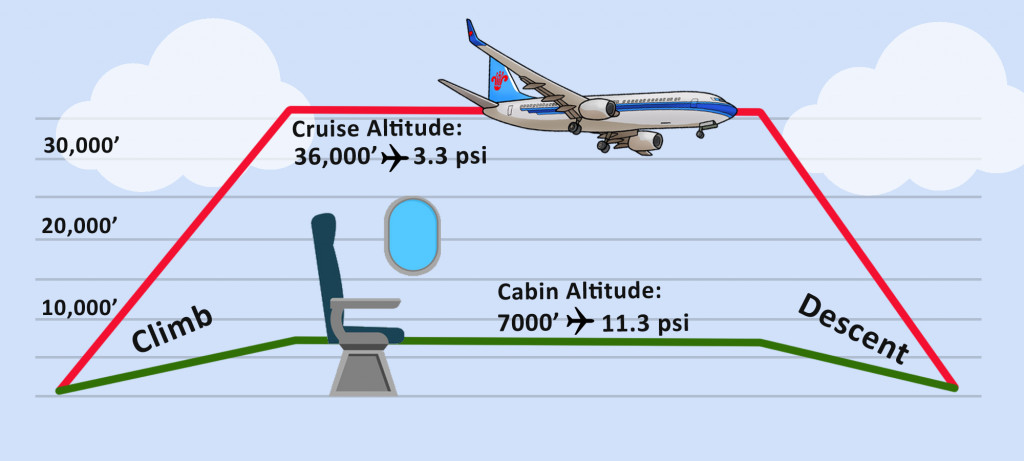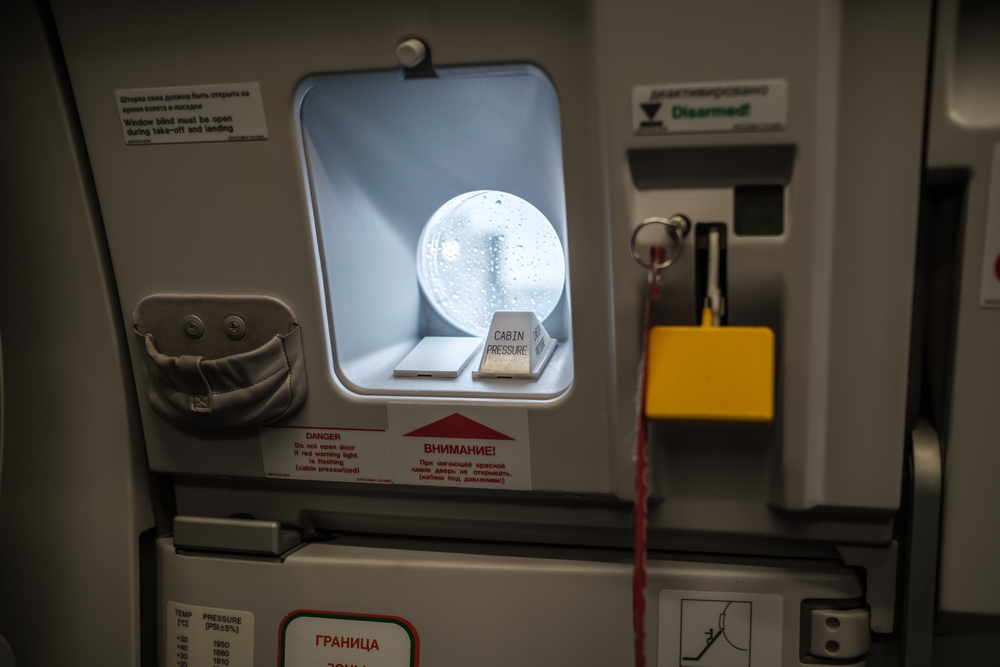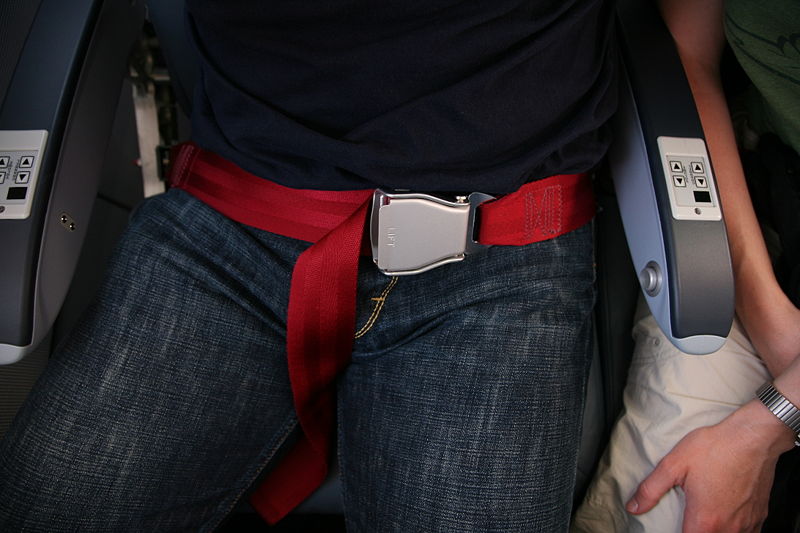Getting sucked out of an airplane is not only fatal for the passenger, but can actually put the safety of the entire flight in jeopardy.
If you’re an infrequent flier like me, your head probably races in all directions before you board a plane, thinking of the many things that could go wrong.
Think about it… you’re in a metal contraption piloted by creatures not designed to fly, sailing several thousand feet above their originally intended habitat.
What could not go wrong?

Running out of fuel mid-air? Engine stalling in flight? Or like they show in movies—getting sucked out of the airplane altogether!
Can You Get Sucked Out Of An Airplane?
While the short answer is yes, the probability of such an event occurring is extremely low.
Still, it helps if we understand the mechanics behind it.
Humans primarily live on land; their internal organs expand and contract in accordance with the atmospheric pressure at mean sea level that is acting on them.
With an increase in altitude, the effective ‘quantity’ of atmosphere acting over you reduces, reducing air pressure along with it. As this is unfavorable for the human body, aircraft cabins are pressurized to emulate atmospheric pressure, even at high altitudes.

Structural damage to an aircraft can cause sudden drops in pressure, forcing air out of the cabin until equilibrium is established. This is known as depressurization. At times, this damage—primarily cracks and holes—are large enough for a human to fit through. The rapid loss of cabin pressure can pick up loose objects, and sometimes even passengers, partially or completely pulling them out of an aircraft.
Types Of Depressurization
Depressurization resulting from structural damage can come in two types. Rapid depressurization refers to the loss of cabin pressure over several seconds. Explosive decompression, on the other hand, takes place in less than half a second.

Another form of depressurization, also known as gradual or insidious depressurization, refers to a slow leak. This can arise from faulty gaskets and door seals, window cracks or a malfunction in the pressurization system.
The rate of depressurization is directly proportional to an aircraft’s altitude and the size of the opening caused by the structural damage. At the same time, it is inversely related to the size of the aircraft cabin. Thus, a larger cabin will take longer to decompress than a smaller cabin.
Also Read: How Do People Get Breathable Air (Oxygen) In Airplanes?
What Happens If You Get Sucked Out Of The Airplane?
Upon accidental depressurization of an aircraft, occupants can experience several things. The sudden reduction in cabin pressure causes altitude-induced decompression sickness and hypoxia, limiting the amount of oxygen available to the blood stream. Other symptoms include ear pain, joint popping, stomach ache, nausea and even a change in color of your lips (to blue!).
Depending on a passenger’s physical state, hypoxia can either set in immediately or gradually. This results in reduced awareness and ability to respond, and eventually complete incapacitation. In order to prevent this, oxygen masks are deployed.

The rapid exit of air from the aircraft can also pick up loose items, such as food trays, personal items and debris, which further increases the chances of injury. The cabin itself experiences a rapid drop in temperature, causing air to fog up due to the condensation of vapor.
Even in such situations, occupants are largely safe thanks to their seat belts and oxygen masks. Pilots usually declare an emergency and rapidly descend to lower altitudes where air pressure and oxygen density are higher, reducing the need to depend on support systems. Commercial aircraft typically cruise between 33,000 and 42,000 ft. In the event of depressurization, pilots will try to reach altitudes of 8,000 ft or less within minutes!

However, someone sucked out of an aircraft is in a highly precarious situation. They are effectively in a high-altitude free fall without any equipment. In such situations, the risks mount quickly and a person’s chances of surviving the fall are extremely bleak.
The danger of hypoxia and extreme lung decompression is huge. High-speed winds at extremely low temperatures make this even more dangerous. Other loose objects or debris being ejected from the plane can collide with the passenger, or the person could even get sucked into the engine itself, which can be detrimental to the flight’s safety.
How Do Paratroopers Jump Off Aircraft?
While armed forces are definitely real-life heroes, they’re not immune to the whims of physics. How do they manage to jump off the back of airplanes without getting sucked out or chopped up by the engines?

For the most part, paratroopers jump off from the lowest possible altitudes, their goal being to reach the ground as quickly as possible. Similarly, skydivers jumping off aircraft for recreational purposes also go to altitudes within the human body’s safe physiological limits.
However, certain military operations require personnel to be airdropped from altitudes as high as 30,000 ft. The trick here is gradual and controlled depressurization. Cargo aircraft have an outflow valve that releases cabin pressure before the bay doors open. This allows paratroopers and any payloads to exit the craft without being forcefully drawn out by depressurization.

Paratroopers attempting high-altitude jumps use an oxygen supply and compression body suits to prevent hypoxia and decompression-related sickness. Furthermore, locating doors aft of the engines eliminates the risk of any paratrooper getting sucked into them.
Also Read: What If You Jumped Out Of An Airplane Into The Sea Without A Parachute?
Conclusion – Is Getting Sucked Out Of An Airplane Really A Threat?
Aviation is amongst the riskiest endeavors undertaken by man. However, the number of instances of people getting sucked out of airplanes are proportionately low. Even the very rare occurrence of such terrible events has prompted a pan-industry design and engineering change, mitigating the risks even further.

Therefore, while it is not uncommon to face depressurization; it is never as dramatic or violent as they show in movies. At the same time, the risk of being sucked out of an airplane is too insignificant to worry about. If flight paranoia still haunts you, using a seat belt as a safety precaution will ensure that you avoid getting ‘caught in the wind’!
Also Read: What Are Ghost Planes? 3 Mysterious Airplane Disappearances From History
How well do you understand the article above!

References (click to expand)
- Combat/Military Free Fall Parachute System. The Ministry of Home Affairs
- Altitude-Induced Decompression Sickness. faa.gov
- Ottestad, W., Hansen, T. A., Pradhan, G., Stepanek, J., Høiseth, L. Ø., & Kåsin, J. I. (2017, December 1). Acute hypoxia in a simulated high-altitude airdrop scenario due to oxygen system failure. Journal of Applied Physiology. American Physiological Society.
- Rapid Depressurisation | SKYbrary Aviation Safety. SKYbrary
- Time of Useful Consciousness | SKYbrary Aviation Safety. SKYbrary
- Explosive Depressurisation | SKYbrary Aviation Safety. SKYbrary
- Cabin Decompression Awareness - SKYbrary. SKYbrary
